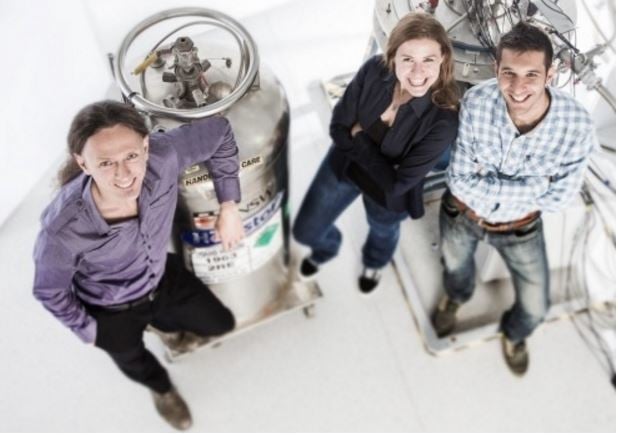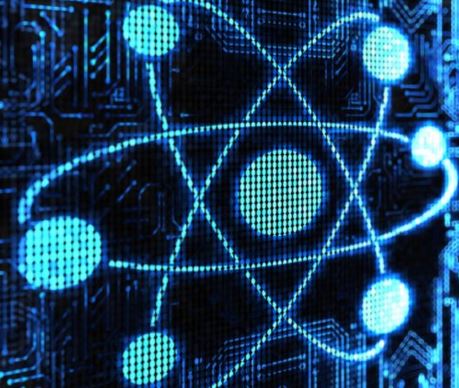A quantum computer using two quantum bits in a silicon chip is possible, thus eliminating doubts about whether code can be made reliably enough to allow quantum computers to operate properly, says a team of Australian engineers.
The researchers, from Australia’s University of New South Wales (UNSW), wrote about their achievement in the academic journal Nature Nanotechnology.
The quantum code was created on a class of phenomena known as quantum entanglement, which allows for the measurement of one particle immediately affecting another, regardless of distance – even if one is at one end of the Universe and the other at the other end.
 Study leader Andrea Morello (left), and lead authors Stephanie Simmons and Juan Pablo Dehollain in the UNSW laboratory where the experiments were done. (Image: UNSW)
Study leader Andrea Morello (left), and lead authors Stephanie Simmons and Juan Pablo Dehollain in the UNSW laboratory where the experiments were done. (Image: UNSW)
‘Spooky action at a distance’
Research leader, Professor Andrea Morello, of the School of Electrical Engineering & Telecommunications at UNSW, who is also Program Manager in the Centre for Quantum Computation & Communication Technology, said:
“This effect is famous for puzzling some of the deepest thinkers in the field, including Albert Einstein, who called it ‘spooky action at a distance’. Einstein was sceptical about entanglement, because it appears to contradict the principles of ‘locality’, which means that objects cannot be instantly influenced from a distance.”
Physicists have long struggled to establish a distinct boundary between our current everyday world – where the laws of classical physics govern – and the enigma of the quantum world.
Over the past five decades, the best guide to that boundary has been Bell’s Inequality, a theorem that states that no local description of our world can reproduce all quantum mechanics’ predictions.
Bell’s Inequality demands an extremely stringent test to determine whether two particles are actually entangled. It is called the Bell Test, so named after John Stewart Bell (1928-1990), a Northern Irish physicist who devised the theorem 51 years ago.
Bell Test passed with highest score ever
Co-lead author, Dr. Juan Pablo Dehollain, a UNSW Research Associate, said:
“The key aspect of the Bell test is that it is extremely unforgiving: any imperfection in the preparation, manipulation and read-out protocol will cause the particles to fail the test.”
“Nevertheless, we have succeeded in passing the test, and we have done so with the highest ‘score’ ever recorded in an experiment.”
 False-colour electron microscope picture of the silicon nanoelectronic device containing the phosphorus atom used for the demonstration of quantum entanglement. (Image: UNSW)
False-colour electron microscope picture of the silicon nanoelectronic device containing the phosphorus atom used for the demonstration of quantum entanglement. (Image: UNSW)
The experiment involved two quantum particles – the nucleus of a single phosphorous atom and an electron. They were placed inside a silicon microchip.
The particles are on top of each other, literally – with the electron orbiting the nucleus. Therefore, no complication arises from the spookiness of action at a distance.
This UNSW experiment – creating these two-particle entangled states – is the equivalent of writing a kind of computer code that does not exist in our current computers.
The Holy Grail in the quantum computer quest?
It therefore shows it is possible to write a purely quantum version of computer code by placing two quantum bits in a silicon chip. This could well be the Holy Grail in the search for an ultra-powerful quantum computer.
Prof. Morello said:
“Passing the Bell test with such a high score is the strongest possible proof that we have the operation of a quantum computer entirely under control. In particular, we can access the purely-quantum type of code that requires the use of the delicate quantum entanglement between two particles.”
In today’s computers, using two bits, one could write four possible code words: 00, 01, 10 and 11. In a quantum computer, on the other hand, one may also write and use ‘superpositions’ of the classical code words, such as (01 + 10) or (00 + 11). For it to be possible, it is necessary to create quantum entanglement between two particles.
Co-author, Stephanie Simmons, UNSW Research Fellow, said:
“These codes are perfectly legitimate in a quantum computer, but don’t exist in a classical one. This is, in some sense, the reason why quantum computers can be so much more powerful: with the same number of bits, they allow us to write a computer code that contains many more words, and we can use those extra words to run a different algorithm that reaches the result in a smaller number of steps.”
Prof. highlighted the importance of this breakthrough using a silicon chip:
“What I find mesmerising about this experiment is that this seemingly innocuous ‘quantum computer code’ – (01 + 10) and (00 + 11) – has puzzled, confused and infuriated generations of physicists over the past 80 years.”
“Now, we have shown beyond any doubt that we can write this code inside a device that resembles the silicon microchips you have on your laptop or your mobile phone. It’s a real triumph of electrical engineering.”
The work was supported by collaborators from Japan’s Keio University, the University of Melbourne, as well as Professor Andrew Dzurak and his team at UNSW.
Citation: “Bell’s inequality violation with spins in silicon,” Juan P. Dehollain, Stephanie Simmons, Juha T. Muhonen, Rachpon Kalra, Arne Laucht, Fay Hudson, Kohei M. Itoh, David N. Jamieson, Jeffrey C. McCallum, Andrew S. Dzurak & Andrea Morello. Nature Nanotechnology. 16 November, 2015. DOI: 10.1038/nnano.2015.262.
UNSW Video – Quantum computing in silicon now possible

